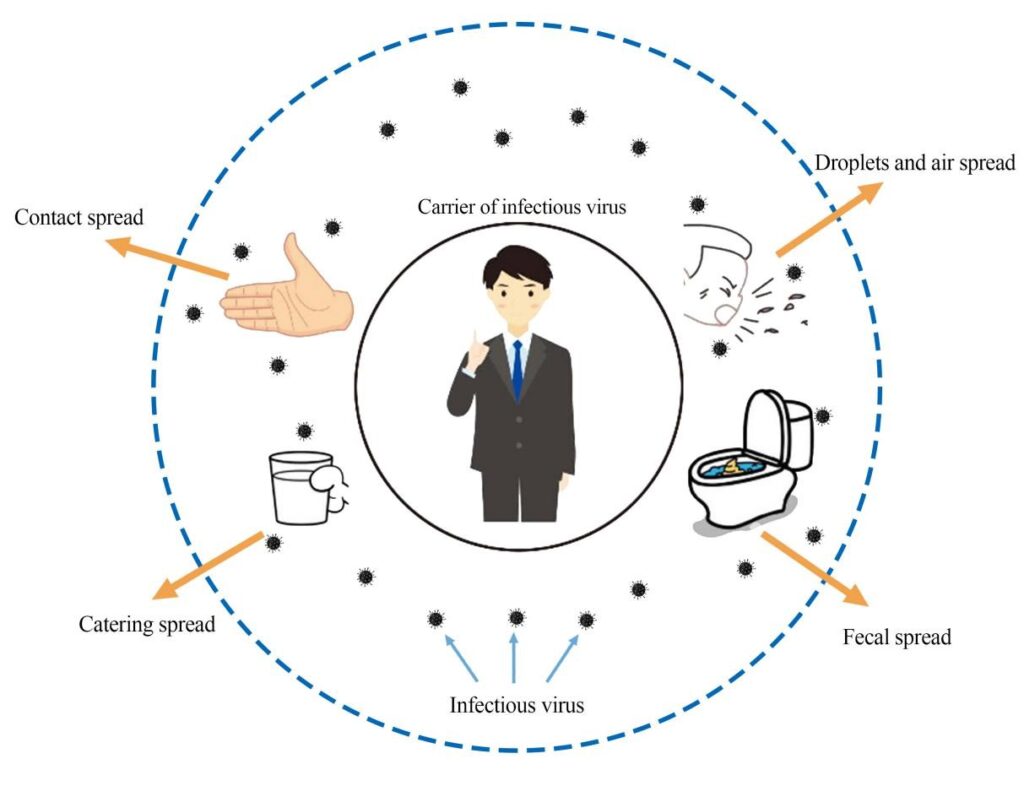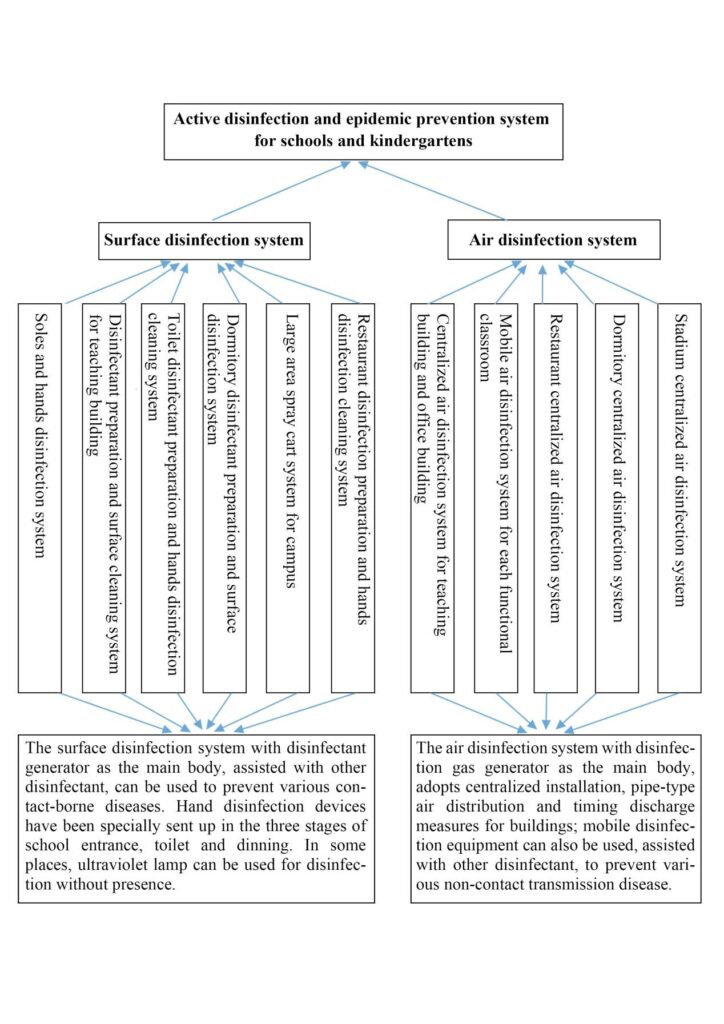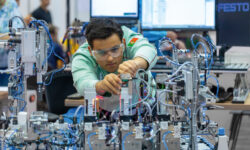
I. The necessity of establishing an active disinfection and epidemic prevention system for schools and kindergartens
- A basic model of respiratory infectious diseases such as COVID-19
So far, the infectious diseases that pose the greatest threat to human health, survival, economic and social order are the respiratory infectious diseases represented by COVID-19, SARS and Middle East Respiratory Syndrome. Summarizing the worldwide spread of this infectious disease, it can be seen that this disease has two major characteristics: foreign input and cross infection; rapid infection and rapid spread. The basic model of its propagation is shown in Figure 1.

Figure 1 Compound transmission model of respiratory infectious virus
It can be seen from the above model that humans are the most critical medium in the rapid spread of respiratory diseases; air is the main way for patients to spread diseases to healthy people. It is based on the above understanding that countries have invariably taken quarantine as the first priority in curbing the epidemic.
2. The spread foundation of respiratory infectious diseases such as COVID-19
The rapid spread of respiratory infectious diseases is, firstly, based on the high-density living and working environment of modern society, as well as high-intensity personal contact; secondly, based on urbanized environment of international convergence today.
Therefore, all kinds of schools and kindergartens have greater transmission risk than other public places because of the high density of personnel, long period of co-existence between teachers and students, high frequency contact of personnel in school, and the relatively weak resistance of students and children to infectious diseases. The danger to all kinds schools and kindergartens lies in that the functions and contents of continuous prevention against such infectious diseases are not included in the premise of their design and construction. Therefore, the seemingly solid campus buildings are actually not fortified against the tiny infectious viruses. In the face of epidemic pressure, countries must take active measures to make up for the above defects as soon as possible, so as to avoid recommitting the same mistakes in the future.
3. Frequency of respiratory infectious diseases such as COVID-19
In 17 years, respiratory infectious diseases have caused at least four global crises, including SARS in 2003, H1N1 highly pathogenic avian influenza in 2009, Middle East respiratory syndrome in 2012, and COVID-19 in 2019. Hence, the whole society must be aware that the emergence of such major infectious diseases is no longer a low probability event. Its high frequency shows that the whole world is at great risk. Thus, constructing an active disinfection and epidemic prevention system around various schools and kindergartens, realizing the normalization of disinfection and epidemic prevention, reversing the passive situation of implementing disinfection after the outbreak, and striving for prevention before it happens, has become an inevitable choice for the future education systems of countries around the world.
Ⅱ.Feasibility of constructing active disinfection and epidemic prevention system for schools and kindergartens
1.Safe disinfection with presence——design basis of active disinfection and epidemic prevention system in schools and kindergartens
According to the experience and lessons from all over the world, the construction foundation of the active disinfection and epidemic prevention system in schools and kindergartens is the safe disinfection with someone present. The transmission model of respiratory infectious diseases (Figure 1) shows that the risk of such diseases lies in the arrival of virus carriers (especially those who have not yet been diagnosed), which can instantly turn the originally clean living and working environment into a high-risk infectious area, thus triggering a chain reaction of infections. After the onset of secondary infections, the local epidemic is difficult to control. The active measures to be taken in this regard include: ①Implementing normalized virus detection for all all personnel—real-time screening of virus carries and taking quarantine and treatment measures at any time; ② Implementing safe disinfection for all public places with people present—avoiding infection by blocking possible transmission channels. After weighing technology and cost, the latter is obviously more feasible.
The traditional idea of disinfection is to disinfect the environment without people. However, the random presence of infectious virus carriers is enough to offset all the efforts of traditional disinfection, and post disinfection can hardly constitute an effective prevention of infectious diseases. In fact, the safe disinfection of someone present is not new, and disinfection of swimming venues belongs to this category. Through nearly a hundred years of practice, human beings have accumulated the experience of ensuring that the free chlorine remaining in swimming pools always maintain sterilization and disinfection capabilities after disinfection under the premise of of ensuring the safety of swimmers. Therefore, with the help relevant high and new technologies, it is completely feasible to develop safer and more effective disinfection methods (such as using chlorine dioxide instead of traditional disinfectants such as chlorine gas, hypochlorous acid, etc.) and achieve normal operation.
2.Achieving the normalization of disinfection and epidemic prevention—The institutional guarantee of active disinfection and epidemic prevention system for schools and kindergartens
The experience of COVID-19 tells us that the current disease control and medical system in each country is not enough to deal with the vicious outbreak of respiratory infectious diseases. Hence, the construction active disinfection and epidemic prevention system for schools and kindergartens is actually a process of promoting the society to shift the epidemic prevention function from full-time departments such as disease control to schools and kindergartens, so as to achieve the normalization of epidemic prevention work.
For this reason, it is necessary for the education systems of all countries to refer to Japan’s successful experience in the construction of major natural disaster prevention systems like in earthquakes, to make good overall design, adhere to publicity and education, formulate relevant specifications, implement effective supervision and promote the construction of active disinfection and epidemic prevention systems for schools and kindergartens in stages and steps.
3.No blind spots in disinfection and epidemic prevention—composition requirements for active disinfection and epidemic prevention system for schools and kindergartens
The active disinfection and epidemic prevention system for schools and kindergartens consists of series of subsystems as shown in Figure 2. By constructing and implementing the normal operation of the above-mentioned subsystems, we can construct a blind corner-free disinfection and epidemic prevention system for schools and kindergartens.

Figure 2 Composition of active disinfection and epidemic prevention system for schools and kindergartens
4.Comprehensive application of chlorine dioxide in surface disinfection and air disinfection—the core means of active disinfection and epidemic prevention for schools and kindergartens
The COVID-19 epidemic has made many people realize chlorine dioxide as a disinfectant for the first time. After a comprehensive comparison of various disinfection and epidemic prevention methods such as physical and chemical, people are surprised to find that chlorine dioxide has become a rising star in the disinfection industry due to its outstanding characteristics of safety, high efficiency, non-toxicity and no residue.
On the principle of disinfection, chlorine dioxide mainly uses strong oxidation ability to capture electrons with the surface of single cell or virus, which makes the cell enzyme system inactivate and die naturally, so as to achieve the effect of disinfection and sterilization. Chlorine dioxide disinfection has a very high directivity, that is, it only works on mononuclear and non-nuclear pathogens (most respiratory viruses including COVID-19 belong to this category), but it is not effective on multicellular organisms. According to the Toxicological Analysis Report of Chlorine Dioxide and Chlorate issued by the U.S. Department of Health and Human Services(US.HHS) in 2020, so far, no toxicological studies have shown that oral administration of chlorine dioxide can cause death or carcinogenesis in humans, and there have been no reports show that human skin exposure to chlorine dioxide can cause cancer and death, so it i currently considered a safer disinfection method than chlorine. This is also the fundamental reason why the World Health Organization (WHO) recommends it as the only safe and reliable A1 disinfectant.
The goal of constructing a active disinfection and epidemic prevention system for schools and kindergartens is to use safe and efficient disinfection means to achieve normal disinfection for schools and kindergartens. The main disinfection tasks include surface disinfection and air disinfection. In the application scenario of chlorine dioxide disinfection stipulated in the Sanitary Standards for Chlorine Dioxide Disinfectants (GB 26366-2010), China specifically proposed disinfection for “general object surfaces”, that is, the disinfection “for surface of daily necessities in households and public places, such as tables, chairs, bedside cabinets, sanitary wares, door and window handles, stair handrails, bus seats and handles, and children’s toys ”. This has basically covered the surface disinfection requirements in the active disinfection and epidemic prevention system for schools and kindergartens. In addition, a large number of studies have proved the outstanding effect of chlorine dioxide in air disinfection, surface disinfection in specific spaces, and fabric and equipment disinfection. The U.S. military and U.S. Centers for Disease Control and Prevention (CDC) have used chlorine dioxide air disinfection as the main safe and efficient disinfection means against Ebola virus and anthrax biochemical attacks. A large number of studies in China have also confirmed that a safe concentration of human body directly exposed to chlorine dioxide gas is initially obtained as 0.090 mg/m3/2h/d when the safety coefficient is converted to 100. At this safe concentration, it has been able to ensure the effective sterilization of bacteria and viruses. Therefore, the safe disinfection based on chlorine dioxide is eligible to become the core means of active disinfection and epidemic prevention system for schools and kindergartens.
Appendix:
Introduction of China Yuanda-llongwill (Platinum Member of Worlddidac) Cleanbao®, llongwill-Cleanbao® series chlorine dioxide disinfectant and disinfection gas production equipment
- llongwill-Cleanbao® C-30 disinfectant preparation system
C-30 disinfectant preparation equipment is equipped with special raw materials, which can produce safe and efficient chlorine dioxide disinfectant with a concentration of 10-160mg/L (concentration adjustable) along with the water source. It can be widely used in spraying, wiping, soaking, washing, and effectively blocking the spread of surface viruses.

- Cleanbao® A-200 mobile air disinfection system
A-200 air disinfection system adopts the mobile design and is equipped with a special formula of solid raw materials, which can meet the requirements of room disinfection below 200m³. It can carry out continuous mobile disinfection for different spaces. The dry disinfection gas released by A-200 can effectively prevent the pathogens through the forms of droplets, air, aerosols, etc.

- Cleanbao® A-100 portable air disinfection system
A-100 air disinfection system is equipped with a special formula of solid raw materials. The dry disinfection gas produced is quickly released in 8 minutes, which can meet the requirements of room disinfection below 100m³. It can effectively sterilize a variety of pathogenic bacteria and viruses, and can effectively remove formaldehyde, hydrogen sulfide and other harmful substances in the air.

- Cleanbao® C-1000 large-scale centralized air disinfection treatment system
C-1000 large-scale centralized air disinfection treatment system supports full-time comprehensive disinfection and sterilization in complex large spaces blow 50000m³. With special air distributors and intelligent control, the real-time produced disinfection gas can be released at multiple spots through the laying pipeline to each room regularly and quantitatively. It is widely used in school classrooms, restaurants, dormitories and other densely populated places.

- llongwill-Cleanbao® sole disinfection device
The sole disinfection device is used in conjunction with C-30 to prepare chlorine dioxide disinfection solution. The upper layer of the device is a disinfection blanket, and the lower layer is disinfection residue liquid. The disinfection solution is sprayed on the disinfection blanket every two hours, and the residence time on the sole disinfection device should not be less than 10-15s.

Application cases
Yuanda-llongwill series disinfection equipment has played a significant role in the prevention of post-disaster epidemic in Houston, USA in 2017 and the epidemic prevention in Weifang, China in 2018. In the outbreak of COVID-19 epidemic in China, Yuanda-llongwill has provided the above professional disinfection equipment to more than 200 schools and kindergartens, dozens of large and medium-sized hospitals and many social institutions, and made great contribution in fighting against the epidemic and blocking the spread of the virus. No infection was found in all user units.
Business Consulting:
Stefanie Li
www.cleanbao.com/EN/
Article Submitted by:
Rui Zhang
Shandong Yuanda-llongwill Educational Science and Technology Ltd.
China
